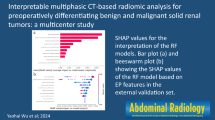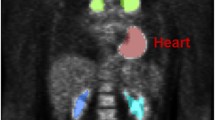Abstract
Objectives
Using a radiomics framework to quantitatively analyze tumor shape and texture features in three dimensions, we tested its ability to objectively and robustly distinguish between benign and malignant renal masses. We assessed the relative contributions of shape and texture metrics separately and together in the prediction model.
Materials and methods
Computed tomography (CT) images of 735 patients with 539 malignant and 196 benign masses were segmented in this retrospective study. Thirty-three shape and 760 texture metrics were calculated per tumor. Tumor classification models using shape, texture, and both metrics were built using random forest and AdaBoost with tenfold cross-validation. Sensitivity analyses on five sub-cohorts with respect to the acquisition phase were conducted. Additional sensitivity analyses after multiple imputation were also conducted. Model performance was assessed using AUC.
Results
Random forest classifier showed shape metrics featuring within the top 10% performing metrics regardless of phase, attaining the highest variable importance in the corticomedullary phase. Convex hull perimeter ratio is a consistently high-performing shape feature. Shape metrics alone achieved an AUC ranging 0.64–0.68 across multiple classifiers, compared with 0.67–0.75 and 0.68–0.75 achieved by texture-only and combined models, respectively.
Conclusion
Shape metrics alone attain high prediction performance and high variable importance in the combined model, while being independent of the acquisition phase (unlike texture). Shape analysis therefore should not be overlooked in its potential to distinguish benign from malignant tumors, and future radiomics platforms powered by machine learning should harness both shape and texture metrics.
Key Points
• Current radiomics research is heavily weighted towards texture analysis, but quantitative shape metrics should not be ignored in their potential to distinguish benign from malignant renal tumors.
• Shape metrics alone can attain high prediction performance and demonstrate high variable importance in the combined shape and texture radiomics model.
• Any future radiomics platform powered by machine learning should harness both shape and texture metrics, especially since tumor shape (unlike texture) is independent of the acquisition phase and more robust from the imaging variations.





Similar content being viewed by others
Abbreviations
- CHA:
-
Convex hull area ratio
- CHP:
-
Convex hull perimeter ratio
- DICOM:
-
Digital imaging and communications in medicine
- EC:
-
Elliptic compactness
- FFT:
-
Fast Fourier transform
- GLCM:
-
Gray-level co-occurrence matrix
- GLDM:
-
Gray-level difference matrix
- HIPAA:
-
Health Insurance Portability and Accountability Act
- PACS:
-
Picture archiving and communication system
- RD:
-
Radial distance
- ROC:
-
Receiver operating characteristic
- ZC:
-
Zero-crossing count
References
Shin T, Duddalwar VA, Ukimura O et al (2017) Does computed tomography still have limitations to distinguish benign from malignant renal tumors for radiologists? Urol Int 99:229–236. https://doi.org/10.1159/000460303
Choudhary S, Rajesh A, Mayer NJ, Mulcahy KA, Haroon A (2009) Renal oncocytoma: CT features cannot reliably distinguish oncocytoma from other renal neoplasms. Clin Radiol 64:517–522. https://doi.org/10.1016/j.crad.2008.12.011
Blute ML, Drewry A, Abel EJ (2015) Percutaneous biopsy for risk stratification of renal masses. Ther Adv Urol 7:265–274. https://doi.org/10.1177/1756287215585273
Gill IS, Aron M, Gervais DA, Jewett MAS (2010) Clinical practice. Small renal mass. N Engl J Med 362:624–634. https://doi.org/10.1056/NEJMcp0910041
Zhu YH, Wang X, Zhang J, Chen YH, Kong W, Huang YR (2014) Low enhancement on multiphase contrast-enhanced CT images: an independent predictor of the presence of high tumor grade of clear cell renal cell carcinoma. AJR Am J Roentgenol 203:W295–W300. https://doi.org/10.2214/AJR.13.12297
Davarpanah AH, Spektor M, Mathur M, Israel GM (2016) Homogeneous T1 hyperintense renal lesions with smooth borders: is contrast-enhanced MR imaging needed? Radiology 280:128–136. https://doi.org/10.1148/radiol.16151240
Ding J, Xing Z, Jiang Z et al (2018) CT-based radiomic model predicts high grade of clear cell renal cell carcinoma. Eur J Radiol 103:51–56. https://doi.org/10.1016/j.ejrad.2018.04.013
Lee-Felker SA, Felker ER, Tan N et al (2014) Qualitative and quantitative MDCT features for differentiating clear cell renal cell carcinoma from other solid renal cortical masses. AJR Am J Roentgenol 203:W516–W524. https://doi.org/10.2214/AJR.14.12460
Patel NS, Poder L, Wang ZJ et al (2009) The characterization of small hypoattenuating renal masses on contrast-enhanced CT. Clin Imaging 33:295–300. https://doi.org/10.1016/j.clinimag.2008.12.002
Coy H, Hsieh K, Wu W et al (2019) Deep learning and radiomics: the utility of Google TensorFlow™ inception in classifying clear cell renal cell carcinoma and oncocytoma on multiphasic CT. Abdom Radiol (NY) 44:2009–2020. https://doi.org/10.1007/s00261-019-01929-0
Li Z-C, Zhai G, Zhang J et al (2019) Differentiation of clear cell and non-clear cell renal cell carcinomas by all-relevant radiomics features from multiphase CT: a VHL mutation perspective. Eur Radiol 29:3996–4007. https://doi.org/10.1007/s00330-018-5872-6
He X, Zhang H, Zhang T et al (2019) Predictive models composed by radiomic features extracted from multi-detector computed tomography images for predicting low- and high- grade clear cell renal cell carcinoma: a STARD-compliant article. Medicine (Baltimore) 98:e13957. https://doi.org/10.1097/MD.0000000000013957
Shu J, Tang Y, Cui J et al (2018) Clear cell renal cell carcinoma: CT-based radiomics features for the prediction of Fuhrman grade. Eur J Radiol 109:8–12. https://doi.org/10.1016/j.ejrad.2018.10.005
Yap FY, Hwang DH, Cen SY et al (2018) Quantitative contour analysis as an image-based discriminator between benign and malignant renal tumors. Urology 114:121–127. https://doi.org/10.1016/j.urology.2017.12.018
Varghese BA, Chen F, Hwang DH et al (2018) Differentiation of predominantly solid enhancing lipid-poor renal cell masses by use of contrast-enhanced CT: evaluating the role of texture in tumor subtyping. AJR Am J Roentgenol 211:W288–W296. https://doi.org/10.2214/AJR.18.19551
Haralick RM, Shanmugam KS, Dinstein I (1973) Textural features for image classification. IEEE Trans Syst Man Cybern 6:610–621. https://doi.org/10.1109/TSMC.1973.4309314
Zwanenburg A, Leger S, Vallières M, et al (2016) Image biomarker standardisation initiative. arXiv preprint arXiv:1612.07003. [cs]
Limkin EJ, Reuzé S, Carré A et al (2019) The complexity of tumor shape, spiculatedness, correlates with tumor radiomic shape features. Sci Rep 9(1):1–12. https://doi.org/10.1038/s41598-019-40437-5
Traverso A, Wee L, Dekker A, Gillies R (2018) Repeatability and reproducibility of radiomic features: a systematic review. Int J Radiat Oncol Biol Phys 102(4):1143–1158. https://doi.org/10.1016/j.ijrobp.2018.05.053
Zhao B, Tan Y, Tsai W-Y et al (2016) Reproducibility of radiomics for deciphering tumor phenotype with imaging. Sci Rep 6(1):1–7. https://doi.org/10.1038/srep23428
Du Q, Baine M, Bavitz K et al (2019) Radiomic feature stability across 4D respiratory phases and its impact on lung tumor prognosis prediction. PLoS One 14(5). https://doi.org/10.1371/journal.pone.0216480
Yang R, Wu J, Sun L et al (2020) Radiomics of small renal masses on multiphasic CT: accuracy of machine learning-based classification models for the differentiation of renal cell carcinoma and angiomyolipoma without visible fat. Eur Radiol 30:1254–1263. https://doi.org/10.1007/s00330-019-06384-5
Kocak B, Ates E, Durmaz ES, Ulusan MB, Kilickesmez O (2019) Influence of segmentation margin on machine learning-based high-dimensional quantitative CT texture analysis: a reproducibility study on renal clear cell carcinomas. Eur Radiol 29:4765–4775. https://doi.org/10.1007/s00330-019-6003-8
Bektas CT, Kocak B, Yardimci AH et al (2019) Clear cell renal cell carcinoma: machine learning-based quantitative computed tomography texture analysis for prediction of Fuhrman nuclear grade. Eur Radiol 29:1153–1163. https://doi.org/10.1007/s00330-018-5698-2
Feng Z, Rong P, Cao P et al (2018) Machine learning-based quantitative texture analysis of CT images of small renal masses: differentiation of angiomyolipoma without visible fat from renal cell carcinoma. Eur Radiol 28:1625–1633. https://doi.org/10.1007/s00330-017-5118-z
Díaz-Uriarte R, Alvarez de Andrés S (2006) Gene selection and classification of microarray data using random forest. BMC Bioinformatics 7(1):3. https://doi.org/10.1186/1471-2105-7-3
Guyon I, Elisseeff A (2003) An introduction to variable and feature selection. J Mach Learn Res:1157–1182
Sotiras A, Gaonkar B, Eavani H et al (2016) Chapter 10 - Machine learning as a means toward precision diagnostics and prognostics. In: Wu G, Shen D, Sabuncu MR (eds) Machine Learning and Medical Imaging. Academic Press, pp 299–334
Pattern Classification, 2nd Edition. In: Wiley.com. https://www.wiley.com/en-us/Pattern+Classification%2C+2nd+Edition-p-9780471056690. Accessed 3 Dec 2018
Bhindi B, Thompson RH, Lohse CM et al (2018) The probability of aggressive versus indolent histology based on renal tumor size: implications for surveillance and treatment. Eur Urol 74:489–497. https://doi.org/10.1016/j.eururo.2018.06.003
Acknowledgments
This study received funding from the Radiological Society of North America (RSNA) Research Fellow Grant (#RF1821) titled “The Shapely Renal Mass: Quantitative Contour Evaluation of Renal Cell Carcinoma.”
Funding
Funding supported by the RSNA Research Fellow Grant #RF1821 titled “The Shapely Renal Mass: Quantitative Contour Evaluation of Renal Cell Carcinoma.”
Author information
Authors and Affiliations
Corresponding author
Ethics declarations
Guarantor
The scientific guarantor of this publication is Vinay A. Duddalwar, MD, FRCR.
Conflict of interest
The authors of this manuscript declare relationships with the following companies:
Vinay Duddalwar, MD, FRCR, is a consultant for Intuitive Surgical and Radmetrix and sits on the advisory board of DeepTek.
Statistics and biometry
Steven Y. Cen (biostatistician), one of the authors, kindly provided statistical support for this manuscript.
Informed consent
Written informed consent was obtained from all subjects (patients) in this study.
Ethical approval
Institutional Review Board approval was obtained.
Study subjects or cohorts overlap
Some study subjects or cohorts have been previously reported in Yap FY, Hwang DH, Cen SY, Varghese BA, Desai B, Quinn BD, et al Quantitative Contour Analysis as an Image-based Discriminator Between Benign and Malignant Renal Tumors. Urology 2018;114:121–7. https://doi.org/10.1016/j.urology.2017.12.018. However, significantly larger sample size and more comprehensive analysis have been performed.
Methodology
• retrospective
• diagnostic study
• performed at one institution (multicenter data)
Additional information
Publisher’s note
Springer Nature remains neutral with regard to jurisdictional claims in published maps and institutional affiliations.
Electronic supplementary material
ESM 1
(DOCX 2485 kb)
Rights and permissions
About this article
Cite this article
Yap, F.Y., Varghese, B.A., Cen, S.Y. et al. Shape and texture-based radiomics signature on CT effectively discriminates benign from malignant renal masses. Eur Radiol 31, 1011–1021 (2021). https://doi.org/10.1007/s00330-020-07158-0
Received:
Revised:
Accepted:
Published:
Issue Date:
DOI: https://doi.org/10.1007/s00330-020-07158-0




